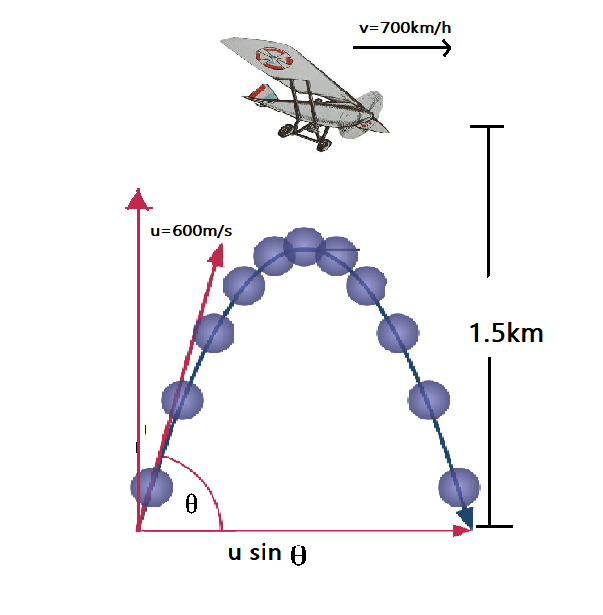
A fighter plane flying horizontally at an altitude of \[1.5km\] with speed $720km/h$ passes directly overhead an anti-aircraft gun. At what angle from the vertical should the gun be fired for the shell with muzzle speed $600ms^{-1}$ to hit the plane? At what minimum altitude should the pilot fly the plane to avoid being hit? (Take $g=10ms^{-2}$)
Answer
585.3k+ views
Hint: This can be solved by the projectile motion where $u \sin\theta=vt$. Since the plane is already at certain height above the ground, we must check, the max height, till where the shell can reach $H_{max}=\dfrac{u^{2}sin^{2}(90-\theta)}{2g}$.
Formula used: $u \sin\theta=vt$
$H_{max}=\dfrac{u^{2}sin^{2}(90-\theta)}{2g}$
Complete step-by-step solution -
This is a projectile motion sum where,
Height of the fighter plane=$1.5km=1500m$
Speed of the plane $v=720km/h=200m/s$
Let $\theta$ be the angle, when the shell hits the plane.
Muzzle velocity $u=600m/s$
Time taken to hit the plane$=t$
Horizontal distance travelled, from second equation of kinematic motion.$=u_{x}t$
Distance travelled by the plane$=vt$

The shell will hit the plane if the above distances are equal.
$u_{x}t=vt$
$u \sin\theta=vt$
$\sin \theta=\dfrac{u}{v}=\dfrac{200}{600}=0.33$
$\theta=\sin^{-1}(0.33)\approx19^{\circ}$
To avoid being hit, the plane must fly at $H_{max}=\dfrac{u^{2}sin^{2}(90-\theta)}{2g}=\dfrac{u^{2}cos^{2}\theta}{2\times10}=\dfrac{600^{2}cos^{2}19}{20}=\dfrac{(600\times0.945)^{2}}{20}=16092=16km$
Since it is already flying at \[1.5km\] height it must fly above by another \[16km\] to avoid being hit by the shell.
Note: Projectile motion occurs when an object is projected at a certain angle from the surface, it moves along a curved path called trajectory under the action of gravity. This curved path is of the shape of a parabola.
The various formulas used are
Time of flight$=\dfrac{2v_{0}\sin\theta}{g}$
Maximum height $H_{max}=\dfrac{u^{2}sin^{2}(90-\theta)}{2g}$
Horizontal range $R=\dfrac{u^{2}sin^{2}(90-\theta)}{g}$
Where, $v_{0}$ is the initial velocity, with $\sin\theta\;;\cos\theta$ as the y-axis and x-axis component respectively.
Formula used: $u \sin\theta=vt$
$H_{max}=\dfrac{u^{2}sin^{2}(90-\theta)}{2g}$
Complete step-by-step solution -
This is a projectile motion sum where,
Height of the fighter plane=$1.5km=1500m$
Speed of the plane $v=720km/h=200m/s$
Let $\theta$ be the angle, when the shell hits the plane.
Muzzle velocity $u=600m/s$
Time taken to hit the plane$=t$
Horizontal distance travelled, from second equation of kinematic motion.$=u_{x}t$
Distance travelled by the plane$=vt$

The shell will hit the plane if the above distances are equal.
$u_{x}t=vt$
$u \sin\theta=vt$
$\sin \theta=\dfrac{u}{v}=\dfrac{200}{600}=0.33$
$\theta=\sin^{-1}(0.33)\approx19^{\circ}$
To avoid being hit, the plane must fly at $H_{max}=\dfrac{u^{2}sin^{2}(90-\theta)}{2g}=\dfrac{u^{2}cos^{2}\theta}{2\times10}=\dfrac{600^{2}cos^{2}19}{20}=\dfrac{(600\times0.945)^{2}}{20}=16092=16km$
Since it is already flying at \[1.5km\] height it must fly above by another \[16km\] to avoid being hit by the shell.
Note: Projectile motion occurs when an object is projected at a certain angle from the surface, it moves along a curved path called trajectory under the action of gravity. This curved path is of the shape of a parabola.
The various formulas used are
Time of flight$=\dfrac{2v_{0}\sin\theta}{g}$
Maximum height $H_{max}=\dfrac{u^{2}sin^{2}(90-\theta)}{2g}$
Horizontal range $R=\dfrac{u^{2}sin^{2}(90-\theta)}{g}$
Where, $v_{0}$ is the initial velocity, with $\sin\theta\;;\cos\theta$ as the y-axis and x-axis component respectively.
Recently Updated Pages
Master Class 11 Economics: Engaging Questions & Answers for Success

Master Class 11 English: Engaging Questions & Answers for Success

Master Class 11 Social Science: Engaging Questions & Answers for Success

Master Class 11 Biology: Engaging Questions & Answers for Success

Class 11 Question and Answer - Your Ultimate Solutions Guide

Master Class 11 Business Studies: Engaging Questions & Answers for Success

Trending doubts
1 Quintal is equal to a 110 kg b 10 kg c 100kg d 1000 class 11 physics CBSE

What is a periderm How does periderm formation take class 11 biology CBSE

What are porins class 11 biology CBSE

Why is steel more elastic than rubber class 11 physics CBSE

Differentiate between red algae and brown algae class 11 biology CBSE

What is boron A Nonmetal B Metal C Metalloid D All class 11 chemistry CBSE




